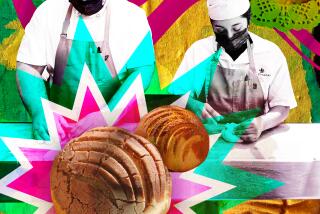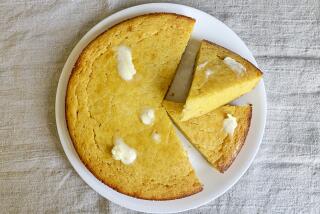Corn : GARDEN FRESH : Corn of Many Colors
- Share via
To most Americans, and most people around the world, corn is either yellow or white. If they only knew what they’re missing--corn is the world’s most colorful grain. For thousands of years American Indians have harvested kernels of many colors, and varieties with stripes and speckles and ombres.
The corn cob begins as a flower stalk, with florets that will develop into kernels. Even when the kernels reach the “milk” stage (when a pierced kernel will spurt a milky substance), almost all varieties of corn are pale. But as the kernels mature, they deepen in color, some magnificently. Most don’t reach their glory until thoroughly mature--that is, bone-dry.
After the colors bloom, you must decide what to do with your gaudy harvest. Grind kernels into meal? Turn them into hominy? Pop and butter them hot? There are several types of corn, classed according to the starch in the kernels. Each type has adapted to a particular function.
The type I find most exciting is flour corn. At the milk stage, ears are good roasted or the kernels can go into fresh tamales. Dried, the kernels are almost completely soft starch, and they easily grind into meal and beautiful flour. They make good hominy as well.
This morning I made exquisite corncakes with flour from Mandan Bride corn, a glorious mix of colors: garnet, mauve, lavender, purple, navy, cranberry, persimmon, chocolate, peach, butter, cream and swirls, as if from a Santa Fe sunset. Together, they grind to grayish meal with myriad specks of color.
Kernels of dent corn have soft, starchy centers and hard sides--as the two parts dry unequally, a dimple dents the kernel’s crown. Bloody Butcher is a 150-year-old dent from Virginia--crimson red kernels with dark-red stripes on pink/red cobs. Easy-growing dents may be used the same as flour corns.
The hard kernels of flint corn contain little soft starch, but their advantage is that many tolerate cool soil, and they mature early--a boon where summers are short. And flints store best of all. Most colorful flints listed by seedsmen are for decoration. But Native Seeds/SEARCH offers flints in luminous colors gathered from remote areas of Mexico. Most are untested, so growing them is an adventure.
Popcorn is akin to flint corn, having hard kernels with no soft starch, and it is considered the most ancient of cultivated corns. The ears are small, but they can be drenched with color, as with the enchanting little strawberry popcorn. I’ve long been partial to Cochiti Pueblo, with many of the colors of Mandan Bride. The sad thing is that when you pop colorful corn, it comes out white, with maybe a dash of color in the throat. At least the kernels are marvelous to look at in a jar. Popcorn kernels are particularly delicious lightly toasted (four to five minutes in a moderate oven), then ground into meal.
Over time, every native community in every region has adopted the corns that grew best for it and gave the community what it needed. Some corns have been bred that produce flour ears next to flint ears on the stalk--and cobs with soft flour kernels next to hard flint kernels--maybe even some dents thrown in. Thus, no matter what the elements bring, there’s precious corn.
Flour, dent, flint and popcorn are called field corn, a rugged term that indicates that most haven’t lost their ability to cope with poor soil and drought. Their pampered offspring, a Johnny-come-lately, is sweet corn. Sweet corn has wrinkled seeds without starch--its sugar not yet converted to starch. That’s why, with old-fashioned cultivars, you must have the kettle boiling before you pick the ears--sugar begins converting to starch the instant the cob leaves the stalk. Most sweet corns are grown for eating in the milk stage, but many cultivars turn colorful when dried and they can be ground for tasty meal. Hooker’s Sweet Indian is one such variety. With a flavor many regard as the finest of all old-fashioned sweet corns, kernels at the milk stage are white and light-yellow. As they mature, they turn purple, then blue-black.
You can sow corn in spring as soon as the soil temperature reaches 65 degrees, and you can keep on sowing for dried corn until about 100 days before autumn’s first expected frost. A happy thing about corn seeds is that the later you sow them, the faster they move. Now is a perfect time to sow something like Hooker’s that you can enjoy at every stage. Or, if your season’s short, sow Mandan Bride, which prospers in cooler climates.
Corn is easy to grow, given its needs--and the more you give your corn, the more it gives you in return. It occurs to me that this responsiveness may be one of the reasons corn was deified by so many cultures. To give you its best, corn wants full sun, soil rich in nitrogen (dig in two or three inches of compost and/or aged manure a spade deep), an inch of water in its basin weekly, no weeds, and earth pushed up around the stalks if there’s wind. A deep mulch of grass clippings or spoiled straw (from a feed store) will conserve water, prevent weeds and nourish the plants.
Corn is pollinated by the wind, so to help the wind do its work, sow seeds in a block--a square of four rows each way with plants set one foot apart is minimum. That will yield 16 ears of every corn--32 to 64 or more of a heritage cultivar such as Hooker’s. Hooker’s is only four to five feet tall, so a row at the back of a mixed bed, with leaves and tassels fluttering in the breeze, makes a merry phalanx.
Because corn is wind-pollinated, you must separate different sorts or you’ll have blue kernels speckled through your golden ears, as I did my first year of growing corn. The surest way to prevent popcorn from toughening sweet corn and super-sweet corn from going hooey is to separate plantings of each sort by four weeks. And don’t forget to consult with corn-growing neighbors before you sow. The wind doesn’t know from property lines.
Now if you want to taste colorful corn but haven’t 16 square feet, you can grow just one plant--or line up your plants like ducks in a row--if you pollinate by hand. It’s a fascinating and simple operation. For every kernel to be filled on the cob, a grain of pollen must fertilize each silk.
The time for pollination is when the dangles on the tassels have turned gold and the silks are thick at the tips of the ears. In the morning, after the dew has dried, gently bend a tassel down into a paper bag and shake in the bright pollen. Tassel released, spread the silks on an ear and, from a corner of the bag, evenly shake about one-half teaspoon of pollen over them. I do this on three successive mornings. And feel like a handmaiden to the wind.
As you do with all crops, rotate corn through your garden, letting three to four years fall between plantings in the same spot. Keep ants and aphids off by strong sprays of water in the morning. Any caterpillars you see nosing about, pick off.
Should there be raccoons in the neighborhood, I’ve found a sure way to keep them out of the patch. I plant summer and winter squashes every three to four feet around the perimeter of the corn. Not only are squashes traditional companions to corn--they profit from one another’s company--but the fastidious raccoons hate the prickly leaves and stems and won’t wade through them, even to get at the corn they adore.
To harvest at the milk stage, wait till the silks have dried, then pull back the leaves on an ear, pierce a kernel with a thumbnail, and if it spurts milk, run and put the kettle on--or lay coals for roasting the ears in their husks.
For dry corn, wait till the stalks are rattly dry. Snip off the ears with shears. Pull back the leaves and silks and hang the cobs in a cool, dark, dry, airy place. When you need their kernels, rub two ears together inside a large paper bag (gloves prevent blisters).
To grind a cup or two of meal, the blender works beautifully. Grind just before you need it, since air causes deterioration of flavor.
The only real trouble I’ve had growing gorgeous colors and affecting heritage cultivars is that now, plain white and yellow hold no magic. . . .
Sources:
Bloody Butcher corn: Seeds Blum, Idaho City Stage, Boise, Idaho 83706.
Mexican flint and popcorn: Native Seeds/SEARCH, 2509 N. Campbell Ave., No. 325, Tucson, Ariz. 85719.
Others: Abundant Life, Box 772, Port Townsend, Wash. 98368.
Culinary blue corn products: Los Chileros de Nuevo Mexico, Box 6215, Santa Fe, N.M. 87502.
*
Freshly ground colored corn has the astonishing taste of toasted walnuts, parched earth and the warm air of a summer day. Because the flavor of corn is so delicate, drizzle honey or berry syrup or salsa over these cakes with a light hand. The cakes are wonderfully versatile. An accompaniment of mixed fresh fruit is perfect--as is caviar and sour cream. They make a fine dinner with beans of any sort and beer. Until you’ve grown your own kernels, you can grind cornmeal from the market or health food store--I find white meal grinds the finest.
AIRY SILVER-DOLLAR CORNCAKES 1/2 cup very finely ground cornmeal (start with 1/3 cup dried flour-variety kernels) 1/2 cup sifted flour 1 tablespoon baking powder 1 tablespoon sugar 1/2 teaspoon salt 1 large egg 3/4 cup milk 1/4 cup sour cream 1/4 cup water Butter
Sift corn meal, flour, baking powder, sugar and salt into mixing bowl. In another bowl, whisk together egg, milk, sour cream and water until blended.
Set 1 or 2 large skillets (preferably cast-iron) over medium-high heat. Add wet mixture to dry mixture and whisk just until smooth. Add 2 tablespoons melted butter and stir just until blended.
Sprinkle drops of water on skillet. If water drops bounce, skillet is ready. Add butter to skillet to film surface. Drop batter by tablespoonful. When tops become bubbly (almost at once), turn and bake about 25 seconds more to brown bottoms. Arrange corncakes overlapping on hot plate and serve at once. Makes about 48 cakes, 3 to 4 servings.
Each of 3 servings contains about: 472 calories; 1,116 mg sodium; 146 mg cholesterol; 30 grams fat; 41 grams carbohydrates; 9 grams protein; 0.2 gram fiber.
More to Read
Eat your way across L.A.
Get our weekly Tasting Notes newsletter for reviews, news and more.
You may occasionally receive promotional content from the Los Angeles Times.










